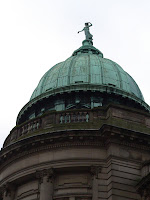The Mitchell: it’s been a good few years now since I wrote this story about my early visits to the main library in Glasgow. It remains one of my regular places to visit. Many libraries try to be both a source for research and study and a place for a neighborhood to experience community. Not all succeed. The Mitchell does, brilliantly.
****
You may learn a good bit about a community and a neighborhood through its library, I’ve found. I’ve spent enough time in Glasgow these last years that I’ve become a card carrying member of Glasgow Libraries.
Most of my time has been at the branch in Royal Exchange Square. That is a warm and welcoming place, a lively and relatively small branch in the basement of the Gallery of Modern Art. It is also the one nearest the Glasgow Royal Concert Hall, good for me as it is music which brings me to the city. Recently, I decided it was time to seek out the main library in Glasgow’s system, The Mitchell.

As it happens, The Mitchell is located just a bit off the the busy M8 highway and a short way from the lively commercial area that makes up the west end of Sauchiehall Street. It is closely surrounded by blocks of nineteenth and early twentieth century flats. As I walked its streets, the neighborhood struck me as a touch drab at first look. Not so, the library.

For one thing, it has an imposing green dome. It has sets of fairly imposing doors, as well. Once you get through them, as with so many buildings in these times, there’s a guard. Turn to your right, though, and you are greeted with an inviting light filled space. There’s an information desk for your questions, a cafe, with people meeting friends or perusing newspapers, a set of computers for library visitors to use, and Just past all this, the book collection begins.
That turns out to be rather imposing as well, although not at all in an off putting sense. The Mitchell is, in fact, one of the largest reference libraries in all of Europe. It is the general collection you encounter first, though, books selected and organized to meet the needs of students on school assignments and neighborhood residents researching a topic or looking for an interesting read. Comfortable chairs, well lighted space, and a warm toned carpet that seems just as inviting as the chairs for sitting down and looking through a book that’s caught your interest. As I took one of those chairs to look at several books on Scotland I knew I’d never find at home, I saw a teenager in full metal and piercings examining books in the nature section, a mother kneeling at a shelf to look at a book her small son was pointing out, and an elderly couple with a sheaf full of notes looking through the shelves of novels. All of us enjoying the resources of the neighborhood library on a quiet weekday morning.
Later, I explored the upper floors of The Mitchell. There is a wide ranging collection of business books and reference sources, and a staff well versed in helping small business people and those who’d like to start such an enterprise research what they need to know. There’s an extensive collection on the history of Glasgow and the history of Scotland, and library experts help people research their own family’s history through original church registers and land records the library holds. There are books and other materials in arts, sciences, and other areas that go into greater depth than the materials on the first floor.
The Mitchell has the largest collection of material relating to Robert Burns in the whole world, as well. That was one of the first areas in which the founders of the Glasgow libraries decided to start collecting when the library began in 1877. Among other things, the library holds several early editions of the ploughman poet’s work, and fourteen of his handwritten letters. There are many translations of his work, including a recent one in Urdu.
I learned, too, that library co ordinates a staff of volunteers who take books out to those who for health and related reasons are not able to visit the library in person. These volunteers are trained to consult with those they visit to determine each person’s ongoing reading interests and on return visits help them use the library’s resources for as long as they cannot come there themselves.
The Mitchell’s current home was built in 1911 and turns one hundred this year. Seeing families and scholars alike at work that morning reading books in the general collection, exploring the history of Robert Burns, and looking through the shelves of books on Scottish music, I had the feeling that the people of the Mitchell and its building had been offering the warmth of welcome to Glaswegians and those from other places who search out its resources for all that century, and are well equipped to do so as the next years unfold.
Consider subscribing to our stories through e mail, and connecting with us through your favorite social networks. You will find links to do that in the sidebar — and while you’re at that social network exploring, we invite you to keep up with our adventures by liking the Perceptive Travel Facebook page.

I visit a lot of libraries when I travel in the United States. They generally have free or very low cost computer use, and they are stocked with local authors that I can list to read later. But I have never visited a library in another country. You’ve shown me the error of my ways. Thanks.
Fascinating! I’ve passed this on to my sister, a librarian who’s studied in Glasgow. No doubt you’re bringing her some good memories.